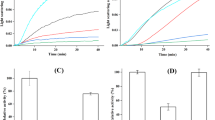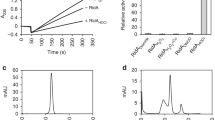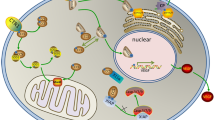Abstract
Encysted embryos of Artemia are among the most stress-resistant eukaryotes partly due to the massive amount of a cysteine-rich protein termed artemin. High number of cysteine residues in artemin and their intramolecular spatial positions motivated us to investigate the role of the cysteine residues in the chaperone-like activity of artemin. According to the result of Ellman’s assay, there are nine free thiols (seven buried and two exposed) and one disulfide bond per monomer of artemin. Subsequent theoretical analysis of the predicted 3D structure of artemin confirmed the data obtained by the spectroscopic study. Native and reduced/modified forms of artemin were also compared with respect to their efficiency in chaperoning activity, tertiary structure, and stability. Since the alkylation and reduction of artemin diminished its chaperone activity, it appears that its chaperoning potential depends on the formation of intermolecular disulfide bond and the presence of cysteine residues. Comparative fluorescence studies on the structure and stability of the native and reduced protein revealed some differences between them. Due to the redox-dependent functional switching of artemin from the less to more active form, it can be finally suggested as a redox-dependent chaperone.





Similar content being viewed by others
References
Ahmad F, Yadav S, Taneja S (1992) Determining stability of proteins from guanidinium chloride transition curves. Biochem J 287(2):481–485. https://doi.org/10.1042/bj2870481
Barford D (2004) The role of cysteine residues as redox-sensitive regulatory switches. Curr Opin Struc Biol 14(6):679–686. https://doi.org/10.1016/j.sbi.2004.09.012
Betz SF (1993) Disulfide bonds and the stability of globular proteins. Protein Sci 2(10):1551–1558. https://doi.org/10.1002/pro.5560021002
Beveridge T, Toma SJ, Nakai S (1974) Determination of SH-and SS-groups in some food proteins using Ellman’s reagent. J Food Sci 39(1):49–51. https://doi.org/10.1111/j.1365-2621.1974.tb00984.x
Bolen DW, Santoro MM (1988) Unfolding free energy changes determined by the linear extrapolation method. 2. Incorporation of. DELTA. G. degree. NU values in a thermodynamic cycle. Biochemistry 27(21):8069–8074. https://doi.org/10.1021/bi00421a014
Chen T, Amons R, Clegg JS, Warner AH, MacRae TH (2003) Molecular characterization of artemin and ferritin from Artemia franciscana. Eur J Biochem 270(1):137–145. https://doi.org/10.1046/j.1432-1033.2003.03373.x
Chen T, Villeneuve TS, Garant KA, Amons R, MacRae TH (2007) Functional characterization of artemin, a ferritin homolog synthesized in Artemia embryos during encystment and diapause. FEBS J 274(4):1093–1101. https://doi.org/10.1111/j.1742-4658.2007.05659.x
Claiborne A, Yeh JI, Mallett TC, Luba J, Crane EJ, Charrier V, Parsonage D (1999) Protein-sulfenic acids: diverse roles for an unlikely player in enzyme catalysis and redox regulation. Biochemistry 38(47):15407–15416. https://doi.org/10.1021/bi992025k
Clegg J (1997) Embryos of Artemia franciscana survive four years of continuous anoxia: the case for complete metabolic rate depression. J Exp Biol 200(Pt 3):467–475
Clegg JS (2011) Stress-related proteins compared in diapause and in activated, anoxic encysted embryos of the animal extremophile, Artemia franciscana. J Insect Physiol 57(5):660–664. https://doi.org/10.1016/j.jinsphys.2010.11.023
Clegg JS, Campagna V (2006) Comparisons of stress proteins and soluble carbohydrate in encysted embryos of Artemia franciscana and two species of Parartemia. Comp Biochem Physiol B: Biochem Mol Biol 145(2):119–125. https://doi.org/10.1016/j.cbpb.2006.04.014
Day RM, Gupta JS, MacRae TH (2003) A small heat shock/α-crystallin protein from encysted Artemia embryos suppresses tubulin denaturation. Cell Stress Chaperones 8(2):183–193. https://doi.org/10.1379/1466-1268(2003)008<0183:ASHCPF>2.0.CO;2
Gajardo GM, Beardmore JA (2012) The brine shrimp Artemia: adapted to critical life conditions. Front Physiol 3:1–8. https://doi.org/10.3389/fphys.2012.00185
Gething MJ, Sambrook J (1992) Protein folding in the cell. Nature 355(6355):33–45. https://doi.org/10.1038/355033a0
Gilbert HF (1993) Molecular and cellular aspects of thiol-disulfide exchange. Adv Enzymol Relat Areas Mol Biol 63:69–172
Gu L, Abulimiti A, Li W, Chang Z (2002) Monodisperse Hsp16. 3 nonamer exhibits dynamic dissociation and reassociation, with the nonamer dissociation prerequisite for chaperone-like activity. J Mol Biol 319(2):517–526. https://doi.org/10.1016/S0022-2836(02)00311-X
Hu Y, Bojikova-Fournier S, King AM, MacRae TH (2011) The structural stability and chaperone activity of artemin, a ferritin homologue from diapause-destined Artemia embryos, depend on different cysteine residues. Cell Stress Chaperones 16(2):133–141. https://doi.org/10.1007/s12192-010-0225-7
Ilbert M, Horst J, Ahrens S, Winter J, Graf PCF, Lilie H, Jakob U (2007) The redox-switch domain of Hsp33 functions as dual stress sensor. Nat Struct Mol Biol 14(6):556–563. https://doi.org/10.1038/nsmb1244
Jacob C, Holme AL, Fry FH (2004) The sulfinic acid switch in proteins. Org Biomol Chem 2(14):1953–1956. https://doi.org/10.1039/b406180b
Janda I, Devedjiev Y, Derewenda U, Dauter Z, Bielnicki J, Cooper DR, Graf PC, Joachimiak A, Jakob U, Derewenda ZS (2004) The crystal structure of the reduced, Zn 2+-bound form of the B. subtilis Hsp33 chaperone and its implications for the activation mechanism. Structure 12(10):1901–1907. https://doi.org/10.1016/j.str.2004.08.003
King AM, Toxopeus J, MacRae TH (2014) Artemin, a diapause-specific chaperone, contributes to the stress tolerance of Artemia franciscana cysts and influences their release from females. J Exp Biol 217(10):1719–1724. https://doi.org/10.1242/jeb.100081
Kumsta C, Jakob U (2009) Redox-regulated chaperones. Biochemistry 48(22):4666–4676. https://doi.org/10.1021/bi9003556
Landino LM, Hasan R, McGaw A, Cooley S, Smith AW, Masselam K, Kim G (2002) Peroxynitrite oxidation of tubulin sulfhydryls inhibits microtubule polymerization. Arch Biochem Biophys 398(2):213–220. https://doi.org/10.1006/abbi.2001.2729
Liang P, MacRae TH (1999) The synthesis of a small heat shock/α-crystallin protein in Artemia and its relationship to stress tolerance during development. Develop Biol 207(2):445–456. https://doi.org/10.1006/dbio.1998.9138
Liang P, Amons R, MacRae TH, Clegg JS (1997) Purification, structure and in vitro molecular-chaperone activity of Artemia p26, a small heat shock/α-crystallin protein. Eur J Biochem 243(1-2):225–232. https://doi.org/10.1111/j.1432-1033.1997.0225a.x
Lin Z, Lei H, Cao P (2007) Expression, purification, and in vitro refolding of soluble tumor necrosis factor-related apoptosis-inducing ligand (TRAIL). Protein Expr Purif 51(2):276–282. https://doi.org/10.1016/j.pep.2006.07.026
MacRae TH (2003) Molecular chaperones, stress resistance and development in Artemia franciscana. Sem Cell Develop Biol 14:251–258. https://doi.org/10.1016/j.semcdb..09.019
Mayer M, Buchner J (2004) Refolding of inclusion body proteins. In: Decker J, Reischl U (eds) Molecular diagnosis of infectious diseases. Humana Press Inc, Totowa, (NJ), pp 239–245
Mcauley A, Jacob J, Carl GK, Westland K, Lee HJ, Stephen RB, Rehder D, Gerd RK, David NB, Matsumura M (2008) Contributions of a disulfide bond to the structure, stability, and dimerization of human IgG1 antibody CH3 domain. Protein Sci 17:95–106. https://doi.org/10.1110/ps.073134408
Miki H, Funato Y (2012) Regulation of intracellular signalling through cysteine oxidation by reactive oxygen species. J Biochem 151(3):255–261. https://doi.org/10.1093/jb/mvs006
Monsellier E, Bedouelle H (2005) Quantitative measurement of protein stability from unfolding equilibria monitored with the fluorescence maximum wavelength. Protein Eng Des Sel 18(9):445–456. https://doi.org/10.1093/protein/gzi046
Niforou K, Cheimonidou C, Trougakos IP (2014) Molecular chaperones and proteostasis regulation during redox imbalance. Redox Biol 2:323–332. https://doi.org/10.1016/j.redox.2014.01.017
Pocker Y, Stone JT (1967) The catalytic versatility of erythrocyte carbonic anhydrase. III. Kinetic studies of the enzyme-catalyzed hydrolysis of p-nitrophenyl acetate. Biochemistry 6(3):668–678. https://doi.org/10.1021/bi00855a005
Qiu Z, MacRae TH (2008a) ArHsp21, a developmentally regulated small heat-shock protein synthesized in diapausing embryos of Artemia franciscana. Biochem J 411(3):605–611. https://doi.org/10.1042/BJ20071472
Qiu Z, MacRae TH (2008b) ArHsp22, a developmentally regulated small heat shock protein produced in diapause-destined Artemia embryos, is stress inducible in adults. FEBS J 275(14):3556–3566. https://doi.org/10.1111/j.1742-4658.2008.06501.x
Rasti B, Shahangian SS, Sajedi RH, Taghdir M, Hasannia S, Ranjbar B (2009) Sequence and structural analysis of artemin based on ferritin: a comparative study. Biochim Bipphys Acta 1794(10):1407–1413. https://doi.org/10.1016/j.bbapap.2009.05.005
Robbins HM, Van Stappen G, Sorgeloos P, Sung YY, MacRae TH, Bossier P (2010) Diapause termination and development of encysted Artemia embryos: roles for nitric oxide and hydrogen peroxide. J Exp Biol 213(9):1464–1470. https://doi.org/10.1242/jeb.041772
Rudolph R, Lilie H (1996) In vitro folding of inclusion body proteins. FASEB J 10(1):49–56. https://doi.org/10.1096/fasebj.10.1.8566547
Shahangian SS, Rasti B, Sajedi RH, Khodarahmi R, Taghdir M, Ranjbar B (2011) Artemin as an efficient molecular chaperone. Protein J 30(8):549–557. https://doi.org/10.1007/s10930-011-9359-4
Shirzad F, Sajedi RH, Shahangian SS, Rasti B, Mosadegh B, Taghdir M, Hosseinkhani S (2011) Deletion of extra C-terminal segment and its effect on the function and structure of artemin. Int J Biol Macromol 49(3):311–316. https://doi.org/10.1016/j.ijbiomac.2011.05.005
Takalloo Z, Sajedi RH, Hosseinkhani S, Asghari SM (2016) Real-time monitoring of artemin in vivo chaperone activity using luciferase as an intracellular reporter. Arch Biochem Biophys 610:33–40. https://doi.org/10.1016/j.abb.2016.09.016
Takalloo Z, Sajedi RH, Hosseinkhani S, Moazzenzade T (2017) Artemin protects cells and proteins against oxidative and salt stress. Int J Biol Macromol 95:618–624. https://doi.org/10.1016/j.ijbiomac.2016.11.088
Trinder P (1969) Determination of glucose in blood using glucose oxidase with an alternative oxygen acceptor. Ann Clin Biochem 6(1):24–27. https://doi.org/10.1177/000456326900600108
Wang CYJ, Huo L, Wang L, Feng W, Wang CC (2012) Human protein-disulfide isomerase is a redox-regulated chaperone activated by oxidation of domain a′. J Biol Chem 287(2):1139–1149. https://doi.org/10.1074/jbc.M111.303149
Wouters MA, Fan SW, Haworth NL (2010) Disulfides as redox switches: from molecular mechanisms to functional significance. Antioxid Redox Signal 12(1):53–91. https://doi.org/10.1089/ARS.2009.2510
Zavialov A, Benndorf R, Ehrnsperger M, Zav’yalov V, Dudich I, Buchner J (1998) The effect of the intersubunit disulfide bond on the structural and functional properties of the small heat shock protein Hsp25. Int J Biol Macromol 22(3-4):163–173. https://doi.org/10.1016/S0141-8130(98)00014-2
Funding
The authors express their gratitude to the research council of Tarbiat Modares University and University of Guilan for financial support during the course of this project.
Author information
Authors and Affiliations
Corresponding author
Rights and permissions
About this article
Cite this article
Mosaddegh, B., Takalloo, Z., Sajedi, R.H. et al. An inter-subunit disulfide bond of artemin acts as a redox switch for its chaperone-like activity. Cell Stress and Chaperones 23, 685–693 (2018). https://doi.org/10.1007/s12192-018-0880-7
Received:
Revised:
Accepted:
Published:
Issue Date:
DOI: https://doi.org/10.1007/s12192-018-0880-7




